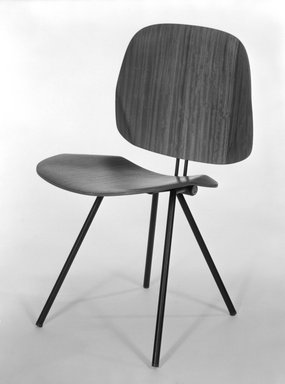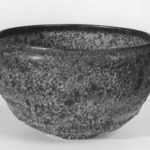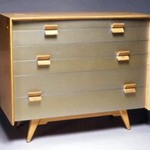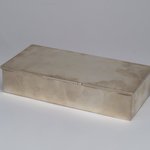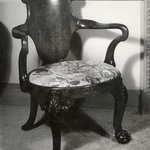Folding Chair (Model S88)
Decorative Arts and Design
Today when we think of where inventive contemporary design
is manufactured, we often think of Italy. This, however, was not
always the case. Wide acceptance of modern design came
somewhat later in Italy than elsewhere, perhaps because of the
ever-present conservative influence of the palpable Roman classical past and the slow development of the Italian economy
in the twentieth century. To be sure, before World War II there
were important modern designers in Italy, foremost Gio Ponti,
an architect from Milan whose influence spread beyond his
native country through two architecture and design magazines he
founded, Domus and Stile. And the Fascist regime of Mussolini in
the pre-World War II period did embrace modern architecture,
unlike the Nazi regime in Germany, which consciously rejected
modernism as a source of foreign, moral corruption. It was not,
however, until the post-World War II era, when the Italian economy
expanded rapidly, that Italian modern design achieved international recognition.
One pivotal event made consumers in the United States aware
of the diversity and accomplishments of modern Italian design—the exhibition Italy at Work, which travelled to twelve venues
between 1950 and 1954. The exhibition was initiated by the Art
Institute of Chicago in partnership with two organizations devoted to the promulgation of Italian design, Handicraft Development
Incorporated in the United States and its corresponding institution
in Italy, CADMA. Italy at Work included hundreds of objects by
more than 150 artisans and manufacturers and featured furniture,
ceramics, glass, textiles, metalwork, jewelry, shoes, knit clothing,
and industrial design. The exhibition opened at the Brooklyn
Museum, and at its conclusion, when the objects were dispersed
among the host institutions, the lion’s share, more than two hundred items, came to the Museum.
In the second half of the twentieth century, Italy became a
center for modern design. Many foreigners went there to study
and work at small, adventurous firms that produced high-quality objects.
MEDIUM
Laminated teak covered plywood and steel
DATES
ca. 1955
DIMENSIONS
31 1/8 x 17 3/4 x 19 7/8 in. (79.1 x 45.1 x 50.5 cm)
(show scale)
MARKINGS
no marks
SIGNATURE
no signature
INSCRIPTIONS
no inscriptions
ACCESSION NUMBER
84.275.1
CREDIT LINE
Gift of Barry Friedman
CATALOGUE DESCRIPTION
Side chair, plywood and tubular steel. Teak molded plywood back and seat of formed, rounded rectangular shape on black, welded steel frame. Pairs of "V" formed legs, welded to center tubular cross piece are set under and towards rear of cantilevered seat. Two slender parallel steel rods rise from cross piece at center of back to hold chair back in place. Folding chair, Model S88.
Condition - Wear marks around edges of seat and back. White paint and/or scratch marks along right rear of seat, and one spot on right edge of back. Along some of the wood seams and along a few minor scratches, areas of a wood tone stain, now turning reddish. On back of seat back a rectangle, about 4"x 6" distinctly darker than rest of app. (perhaps a marking former label?). Minor wear marks on legs.
MUSEUM LOCATION
This item is not on view
CAPTION
Osvaldo Borsani (Italian, born Switzerland, 1911-1985). Folding Chair (Model S88), ca. 1955. Laminated teak covered plywood and steel, 31 1/8 x 17 3/4 x 19 7/8 in. (79.1 x 45.1 x 50.5 cm). Brooklyn Museum, Gift of Barry Friedman, 84.275.1. Creative Commons-BY (Photo: Brooklyn Museum, 84.275.1_bw.jpg)
IMAGE
overall, 84.275.1_bw.jpg. Brooklyn Museum photograph
"CUR" at the beginning of an image file name means that the image was created by a curatorial staff member. These study images may be digital point-and-shoot photographs, when we don\'t yet have high-quality studio photography, or they may be scans of older negatives, slides, or photographic prints, providing historical documentation of the object.
RIGHTS STATEMENT
Creative Commons-BY
You may download and use Brooklyn Museum images of this three-dimensional work in accordance with a
Creative Commons license. Fair use, as understood under the United States Copyright Act, may also apply.
Please include caption information from this page and credit the Brooklyn Museum. If you need a high resolution file, please fill out our online
application form (charges apply).
For further information about copyright, we recommend resources at the
United States Library of Congress,
Cornell University,
Copyright and Cultural Institutions: Guidelines for U.S. Libraries, Archives, and Museums, and
Copyright Watch.
For more information about the Museum's rights project, including how rights types are assigned, please see our
blog posts on copyright.
If you have any information regarding this work and rights to it, please contact
copyright@brooklynmuseum.org.
RECORD COMPLETENESS
Not every record you will find here is complete. More information is available for some works than for others, and some entries have been updated more recently. Records are frequently reviewed and revised, and
we welcome any additional information you might have.
